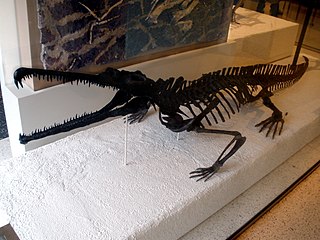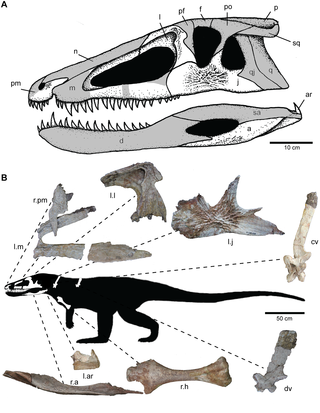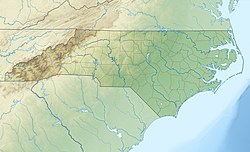
Revueltosaurus is an extinct genus of suchian pseudosuchian from Late Triassic deposits of New Mexico, Arizona and North Carolina, United States. Many specimens, mostly teeth, have been assigned to Revueltosaurus over the years. Currently, three species are included in this genus, all of which were originally thought to represent monospecific genera of basal ornithischian dinosaurs. Revueltosaurus was about 1 meter long.

Rutiodon is an extinct genus of mystriosuchine phytosaurs from the Late Triassic of the eastern United States. The type species of Rutiodon, Rutiodon carolinensis, encompasses a large number of skulls and assorted postcranial fossils discovered in the Cumnock Formation of North Carolina. Fossils referable to the species are also known from Pennsylvania, New Jersey, and Virginia. Rutiodon carolinensis is the most well-described species of phytosaur in eastern North America, though its validity as a natural taxon has been questioned. Some paleontologists also recognize a larger and more robust species, Rutiodon manhattanensis, which is known from teeth and postcranial fossils from New Jersey and Pennsylvania.
The Newark Supergroup, also known as the Newark Group, is an assemblage of Upper Triassic and Lower Jurassic sedimentary and volcanic rocks which outcrop intermittently along the east coast of North America. They were deposited in a series of Triassic basins, the Eastern North American rift basins, approximately 220–190 million years ago. The basins are characterized as aborted rifts, with half-graben geometry, developing parallel to the main rift of the Atlantic Ocean which formed as North America began to separate from Africa. Exposures of the Newark Supergroup extend from South Carolina north to Nova Scotia. Related basins are also found underwater in the Bay of Fundy. The group is named for the city of Newark, New Jersey.

Litargosuchus is a sphenosuchian crocodylomorph, a basal member of the crocodylomorph clade from the Early Jurassic of South Africa. Its genus name Litargosuchus is derived from Greek meaning "fast running crocodile" and its species name leptorhynchus refers to its gracile snout. Litargosuchus, along with all of South Africa's crocodylomorph taxa, are confined to the upper Elliot Formation (UEF) in South Africa.

The Ischigualasto Formation is a Late Triassic geological formation in the Ischigualasto-Villa Unión Basin of southwestern La Rioja Province and northeastern San Juan Province in northwestern Argentina. The formation dates to the late Carnian and early Norian stages of the Late Triassic, according to radiometric dating of ash beds.
Arganodus is an extinct genus of freshwater lungfish that had a wide global distribution throughout much of the Triassic period, with a single species surviving across Gondwana into the Cretaceous. It is the only member of the family Arganodontidae, although it is sometimes placed in the Ceratodontidae or synonymized with the genus Asiatoceratodus.

The Elliot Formation is a geological formation and forms part of the Stormberg Group, the uppermost geological group that comprises the greater Karoo Supergroup. Outcrops of the Elliot Formation have been found in the northern Eastern Cape, southern Free State, and in the eastern KwaZulu-Natal provinces of South Africa. Outcrops and exposures are also found in several localities in Lesotho such as Qacha's Neck, Hill Top, Quthing, and near the capital, Maseru. The Elliot Formation is further divided into the lower (LEF) and upper (UEF) Elliot formations to differentiate significant sedimentological differences between these layers. The LEF is dominantly Late Triassic (Norian-Hettangian) in age while the UEF is mainly Early Jurassic (Sinemurian-Pliensbachian) and is tentatively regarded to preserve a continental record of the Triassic-Jurassic boundary in southern Africa. This geological formation is named after the town of Elliot in the Eastern Cape, and its stratotype locality is located on the Barkly Pass, 9 km north of the town.
Coahomasuchus is an extinct genus of aetosaurine aetosaur. Remains of the genus have been found from deposits in Texas and North Carolina that date to the Otischalkian faunachron of the Late Triassic. It was small for an aetosaur, being less than 1.5 metres long. The dorsal plates are distinctively flat and unflexed, and have a faint sub-parallel to radial ornamentation. The genus lacked spines or keels on these plates, features seen in many other aetosaurs. Coahomasuchus was very similar in appearance to the closely related Aetosaurus.
Euscolosuchus is an extinct genus of suchian archosaurs from the Late Triassic of Virginia. It is probably an aetosauriform, as the sister taxon to Acaenasuchus and a relative of aetosaurs.

The Cow Branch Formation is a Late Triassic geologic formation in Virginia and North Carolina in the eastern United States. The formation consists of cyclical beds of black and grey lacustrine (lake) mudstone and shale. It is a konservat-lagerstätte renowned for its exceptionally preserved insect fossils, along with small reptiles, fish, and plants. Dinosaur tracks have also been reported from the formation.
Uatchitodon is an extinct genus of Late Triassic reptile known only from isolated teeth. Based on the structure of the teeth, Uatchitodon was probably a carnivorous archosauromorph. Folded grooves on the teeth indicate that the animal was likely venomous, with the grooves being channels for salivary venom. The teeth are similar to those of living venomous squamates such as Heloderma and venomous snakes. Uatchitodon is the earliest known venomous reptile.
Boreogomphodon is an extinct genus of traversodontid cynodonts from the Late Triassic of the eastern United States. Fossils have been found from the Turkey Branch Formation in Virginia and the Pekin Formation of North Carolina.
The Cumnock Formation is a Late Triassic-age geologic formation in North Carolina. It is found in the Sanford sub-basin of the Deep River Basin, the southernmost of the large Mesozoic basins forming the Newark Supergroup. It is the middle unit of the Chatham Group, overlying the Pekin Formation and underlying the Sanford Formation. Both of these encompassing formations are primarily red sandstone. The Cumnock Formation, on the other hand, represents a sequence of darker lacustrine (lake) or paludal (swampy/marshy) sediments deposited in a tropical climate. These primarily include shales and coal, with some thin layers of coarser sediment such as siltstone and sandstone.
The Chatham Group is a Triassic-age geologic group in the eastern United States. It is one of the most fossiliferous sections of the Newark Supergroup, preserving much of the Late Triassic up until the Triassic-Jurassic mass extinction. The group was originally named to refer to Triassic rocks specifically within the Deep River Basin of North Carolina. Later studies have utilized it to encompass Late Triassic strata in most other sedimentary basins in the Newark Supergroup.
Lindsay E. Zanno is an American vertebrate paleontologist and a leading expert on theropod dinosaurs and Cretaceous paleoecosystems. She is the Head of Paleontology at the North Carolina Museum of Natural Sciences and an Associate Research Professor in the Department of Biological Sciences at North Carolina State University.

Carnufex is an extinct genus of crocodylomorph suchian from the Late Triassic of North America. The genus was first described in 2015 by Zanno et al., who named the binomial Carnufex carolinensis, meaning "Carolina butcher". Two specimens are known, the holotype skull and skeleton NCSM 21558, and the referred humerus NCSM 21623. The specimens are from the Carnian-age Pekin Formation, which dates to 231 million years ago. Based on the holotype, Carnufex would have been about 3 m (9.8 ft) long and 1.5 m (4.9 ft) tall, although it may have gotten larger due to the holotype not being fully grown.
Gorgetosuchus is an extinct genus of aetosaur from the Late Triassic of the North Carolina, represented by the type species Gorgetosuchus pekinensis. It is mainly known from osteoderms, including the front half of an articulated carapace. Gorgotesuchus is typically considered a basal desmatosuchin, though alternative interpretations exist.
The Sanford Formation is a Late Triassic (Norian)-age geologic formation in North Carolina. It is mainly found in the Sanford sub-basin of the Deep River Basin, the southernmost of the large Mesozoic basins forming the Newark Supergroup. It is the highest unit of the Chatham Group, overlying the dark lake and swamp sediments of the Cumnock Formation. The Sanford Formation is composed primarily of coarse red sediments such as conglomerates, sandstones, and mudstones. The conglomerate layers contain pebbles of schist and slate, with the occasional large boulders of granite.
The Timezgadiouine Formation, sometimes spelled as the Timesgadiouine Formation, is a Triassic geological formation in the Argana Basin of Morocco. It is a succession of red bed sediments spanning from the Olenekian to at least the Carnian, encompassing members T3 to T5 of the Argana Group. It is preceded by the Permian Ikakern Formation and succeeded by the Late Triassic Bigoudine Formation.
Eoginkgoites is an extinct form genus of bennettitalean leaves from the Late Triassic of North America. Despite its palmate (hand-shaped) appearance similar to some early ginkgo species, it belongs to a different gymnosperm order, the Bennettitales. The leaf is deeply segmented into five to seven narrow, club-shaped lobes which twist around a very short rhachis. This leads to an overall fan-shaped leaf situated at the end of a long petiole. The leaf has paracytic stomata and veins which strongly branch and lead to a marginal vein at the edge of each leaflet. These structural traits are all shared with benettitaleans. Williamsonia carolinensis, an ovule-bearing bennettitalean cone, has been found closely associated with Eoginkgoites leaves, seemingly confirming its benettitalean identity.
















